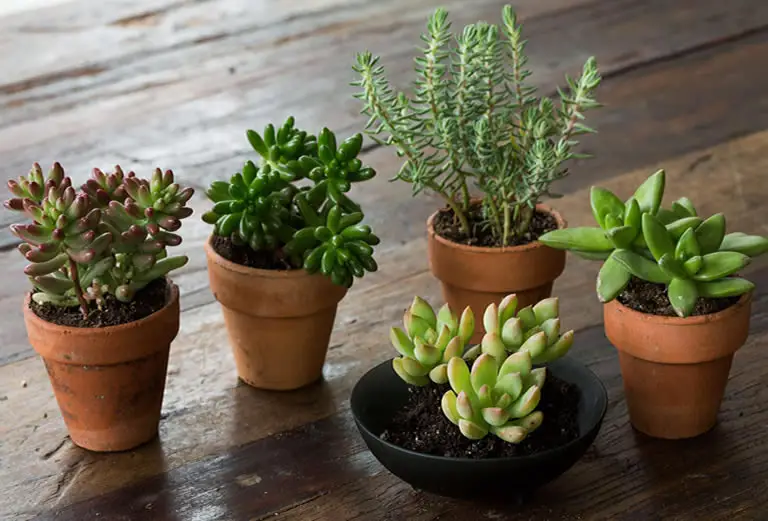Whether you’re decorating a sunny windowsill, filling a quirky container, or just want something that won’t die if you forget a watering or two, succulents are the way to go.
These 30 succulent houseplants are ideal for beginners. They’re low-maintenance, drought-tolerant, and come in an incredible range of shapes, colors, and textures.
Let’s dig in—starting with a true classic.
Table of Contents
- Quick List of 30 Easy-Care Succulent Houseplants
- Aloe Vera
- Bear’s Paw (Cotyledon tomentosa)
- Burro’s Tail (Sedum morganianum)
- Cactus (Various Types)
- Christmas Cactus (Schlumbergera)
- Crown of Thorns (Euphorbia milii)
- Devil’s Backbone (Euphorbia tithymaloides)
- Donkey’s Tail (Sedum burrito)
- Elephant Bush (Portulacaria afra)
- Echeveria
- Flapjack Plant (Kalanchoe luciae)
- Ghost Plant (Graptopetalum paraguayense)
- Hens and Chicks (Sempervivum spp.)
- Hoya (Hoya carnosa)
- Jade Plant (Crassula ovata)
- Kalanchoe (Kalanchoe blossfeldiana)
- Lace Aloe (Aloe aristata)
- Lithops (Living Stones)
- Moonstones (Pachyphytum oviferum)
- Panda Plant (Kalanchoe tomentosa)
- Peanut Cactus (Echinopsis chamaecereus)
- Pencil Cactus (Euphorbia tirucalli)
- Pleiospilos nelii (Split Rock)
- Ponytail Palm (Beaucarnea recurvata)
- Purslane (Portulaca oleracea)
- Ruby Necklace (Othonna capensis)
- Snake Plant (Dracaena trifasciata)
- String of Bananas (Senecio radicans)
- String of Pearls (Senecio rowleyanus)
- Zebra Haworthia (Haworthiopsis attenuata)
- ZZ Plant (Zamioculcas zamiifolia)
- Final Thoughts
Quick List of 30 Easy-Care Succulent Houseplants
Below is a list of 30 low-maintenance succulent houseplants perfect for beginners.
This section is for quick reference and easy access.
Be sure to scroll down and visit the section about each individual plant to learn their basic care needs—and discover why they’re such excellent choices for new plant parents.
Aloe Vera
Bear’s Paw (Cotyledon tomentosa)
Burro’s Tail (Sedum morganianum)
Cactus (various types)
Christmas Cactus (Schlumbergera)
Crown of Thorns (Euphorbia milii)
Devil’s Backbone (Euphorbia tithymaloides)
Donkey’s Tail (Sedum burrito)
Elephant Bush (Portulacaria afra)
Echeveria
Flapjack Plant (Kalanchoe luciae)
Ghost Plant (Graptopetalum paraguayense)
Hens and Chicks (Sempervivum)
Hoya
Jade Plant (Crassula ovata)
Kalanchoe (Kalanchoe blossfeldiana)
Lace Aloe (Aloe aristata)
Lithops (Living Stones)
Moonstones (Pachyphytum oviferum)
Panda Plant (Kalanchoe tomentosa)
Peanut Cactus (Echinopsis chamaecereus)
Pencil Cactus (Euphorbia tirucalli)
Pleiospilos nelii (Split Rock)
Ponytail Palm (Beaucarnea recurvata)
Purslane (Portulaca oleracea)
Ruby Necklace (Othonna capensis)
Snake Plant (Dracaena trifasciata)
String of Bananas (Senecio radicans)
String of Pearls (Senecio rowleyanus)
Zebra Haworthia (Haworthiopsis attenuata)
Aloe Vera
If you’re new to succulents and want something tough and timeless, Aloe Vera is the perfect place to begin.
This widely loved plant forms a tight rosette of thick, pointed leaves filled with soothing gel that can be used for burns or skin irritation.
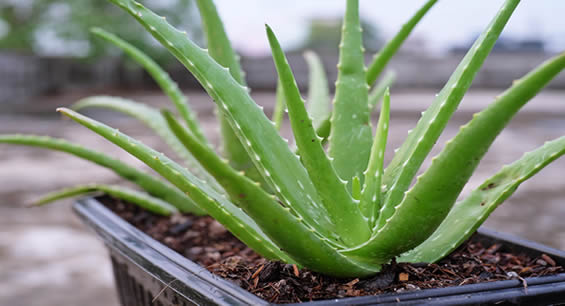
Its bright green foliage can grow up to 20 inches long and develops more character as it matures, sometimes with soft serrations along the edges.
Aloe Vera is one of the fastest growers in the aloe family and thrives on very little attention—as long as it gets enough light.
Lighting needs
Aloe Vera loves direct sunlight and thrives with 6 to 8 hours of full sun each day.
A bright, south- or west-facing window is ideal, though it can tolerate a bit of dappled afternoon shade.
Too little light will slow growth and cause the leaves to stretch or lose their shape.
Soil and watering
This is a true desert plant, so it needs well-draining, sandy soil.
Let at least half the potting mix dry out before watering again, and when you do water, give it a deep, thorough soak.
Avoid letting water sit in the center of the rosette—it can cause rot.
In winter, cut back on watering even more, since the plant naturally slows down during cooler months.
Why it’s great for beginners
Aloe Vera thrives on neglect and forgives most mistakes.
As long as you don’t overwater and give it plenty of sun, it’ll reward you with steady growth and soothing benefits—all with hardly any maintenance.
For a more detailed look at growing and caring for this succulent visit our article Aloe Plant Care Basics For A Healthy Vibrant Succulent.
Bear’s Paw (Cotyledon tomentosa)
If you’re after a plant that looks like something out of a fairytale, Bear’s Paw delivers—with thick, fuzzy leaves shaped like chubby paws, often tipped in red.

It’s a compact, slow-growing succulent that looks fantastic in small pots, and its soft texture makes it one of the most charming choices on this list.
Despite its cuddly look, it’s a desert native that loves the sun and doesn’t need much water.
Lighting needs
Bear’s Paw needs bright, indirect light, and can handle a few hours of morning or late-afternoon sun.
Too much direct sunlight can scorch the edges, especially when the plant is young.
A bright windowsill or sunroom is perfect.
Soil and watering
Use fast-draining soil—either a cactus mix or a blend of potting soil with added sand or perlite.
Let the soil dry out completely between waterings, and avoid splashing water on the fuzzy leaves.
During winter, cut back watering even more to prevent root rot.
Why it’s great for beginners
This plant is low-maintenance and fun to grow, but its real appeal lies in its soft, paw-shaped leaves.
It’s a playful addition to any collection, and as long as you don’t overwater, it’ll thrive on neglect.
Burro’s Tail (Sedum morganianum)
Burro’s Tail is a trailing succulent with thick, bead-like leaves packed tightly along drooping stems.
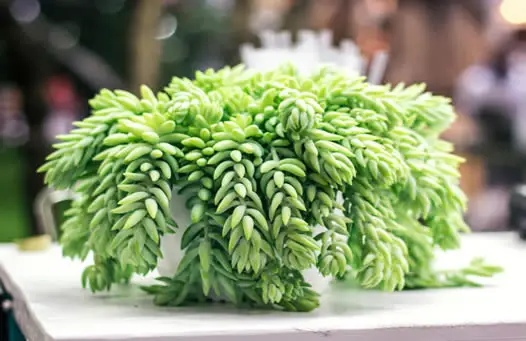
Its cascading growth makes it a favorite for hanging baskets, shelves, and plant stands, where its stems can trail dramatically over the edges.
This plant has a delicate look but a tough constitution—just don’t touch it too much, as the leaves fall off easily.
Lighting needs
Bright, indirect light is best.
It can handle some direct sun, but harsh rays can burn the leaves, especially if the plant has just been watered.
East- or west-facing windows work well.
Soil and watering
Use a well-draining cactus or succulent mix.
Let the soil dry out fully between waterings, and water deeply when you do.
Be gentle when handling—those trailing stems may look strong, but they’re fragile.
Why it’s great for beginners
Once settled in a bright spot, Burro’s Tail requires little care.
It may grow slowly at first, but with patience, it rewards you with lush, trailing stems that look stunning in any setup.
Cactus (Various Types)
It wouldn’t be a list of easy-care succulents without cacti.
These spiny classics come in endless shapes and sizes—from short and round to tall and columnar.
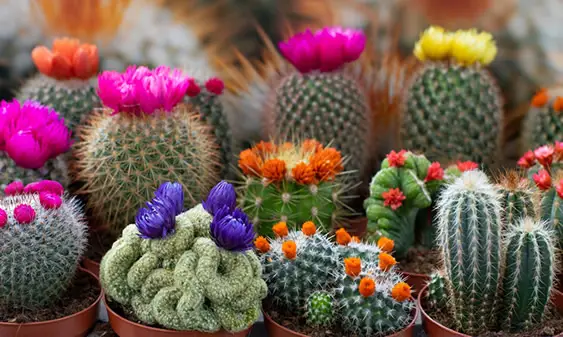
Cacti are known for their toughness and drought resistance, making them perfect for anyone who wants the lowest of low-maintenance plants.
They’re practically made for beginners.
Lighting needs
Most cacti prefer full sun, so place them in a south- or west-facing window where they can soak up plenty of light.
Some types, like Christmas cactus or jungle cacti, prefer indirect light instead—so always check the variety you’ve chosen.
Soil and watering
Use a cactus-specific soil mix with fast drainage.
Water only when the soil is bone dry, and even less in winter.
Too much water is the fastest way to kill a cactus.
Why it’s great for beginners
Cacti are survivors.
As long as you give them enough light and avoid overwatering, they’ll thrive for years with minimal effort—and add bold, architectural flair to your space.
Christmas Cactus (Schlumbergera)
Christmas Cactus brings a different kind of succulent energy—soft, segmented stems and vibrant blooms that appear right around the holidays.
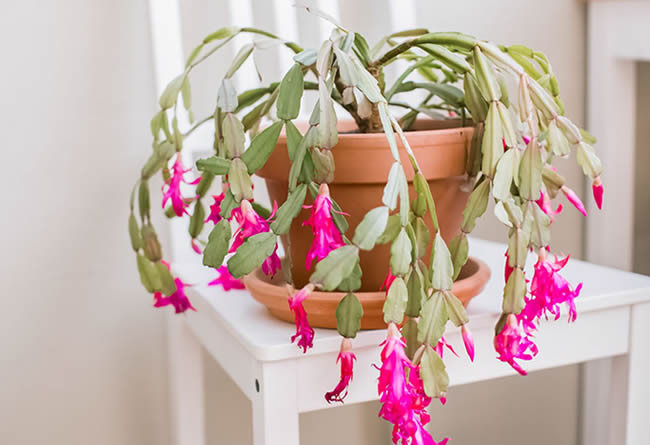
Unlike most succulents, this one comes from tropical forests rather than deserts, so it likes more moisture and shade than you’d expect.
Its blooming colors range from red and pink to white and purple, making it a showstopper when in full bloom.
Lighting needs
Bright, indirect light is ideal.
Too much direct sun can scorch the leaves, so east-facing windows are a great option.
It also adapts well to fluorescent lighting, making it suitable for offices and kitchens.
Soil and watering
Use a well-draining mix, but keep the soil slightly more moist than you’d normally do for desert succulents.
Let the top inch dry out between waterings, and reduce watering in the fall to encourage blooming.
Avoid letting it sit in soggy soil.
Why it’s great for beginners
Christmas Cactus is forgiving, beautiful, and easy to propagate from stem cuttings.
Its tropical succulent nature makes it a bit different—and surprisingly resilient for a flowering houseplant.
For a more detailed look at growing and caring for this succulent visit our article The 8 Essentials Of Good Christmas & Holiday Cactus Care.
Crown of Thorns (Euphorbia milii)
With thick stems, small green leaves, and bold blooms that appear nearly year-round, Crown of Thorns adds a splash of color to any sunny windowsill.
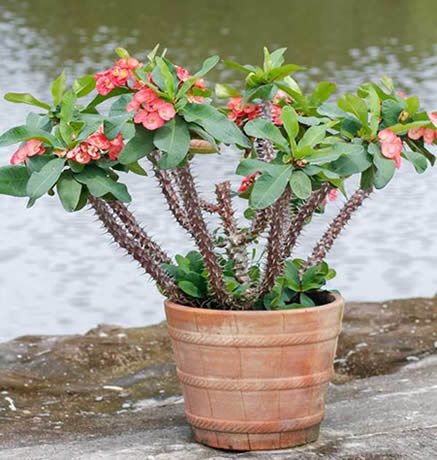
Despite its name and spiky stems, this succulent is a peaceful houseplant that’s surprisingly easy to grow indoors.
It even thrives with a bit of neglect.
Lighting needs
Loves full sun.
Place it in your brightest window—south-facing is best.
It needs at least 3–4 hours of direct sunlight daily to encourage blooming.
Soil and watering
Use a cactus mix or sandy soil with excellent drainage.
Let the soil dry out completely between waterings, and water thoroughly when it’s time.
It tolerates dry air and doesn’t mind being root-bound.
Why it’s great for beginners
Crown of Thorns is colorful, unfussy, and drought-tolerant.
Its tolerance for neglect and ability to bloom indoors make it a standout for new plant owners.
Devil’s Backbone (Euphorbia tithymaloides)
Devil’s Backbone is a quirky, zigzagging succulent with red stems and green leaves that grow in alternating directions—giving it a sculptural, architectural look.

It’s unusual, upright, and perfect for a bold design statement in your home.
Some varieties even have variegated or reddish leaves for extra visual appeal.
Lighting needs
Bright, indirect light is best, though it can handle a bit of direct sun each day.
Rotate the plant occasionally to maintain its symmetrical shape.
Soil and watering
Plant it in a well-draining cactus or succulent mix.
Let the soil dry out between waterings, and be careful not to overwater.
It’s highly drought-tolerant once established.
Why it’s great for beginners
This plant is tough, visually unique, and thrives on low water and minimal care.
It’s a great choice if you’re looking for something low-maintenance but with high design impact.
Donkey’s Tail (Sedum burrito)
Often confused with Burro’s Tail, Donkey’s Tail is its chubbier cousin—with even plumper, bead-like leaves that cascade over the sides of its pot.

This plant grows long, trailing stems that can reach over a foot in length, making it ideal for hanging baskets or tall shelves.
Its silvery green foliage adds a soft, textural look to any space.
Lighting needs
Bright, indirect light is best.
A few hours of morning sun will help it thrive, but strong afternoon rays may cause leaf scorch.
East-facing windows or filtered south light work perfectly.
Soil and watering
Plant it in a gritty, well-draining succulent mix.
Let the soil dry out completely before watering again, and always water deeply but infrequently.
Avoid touching the leaves too much—they’re delicate and fall off easily.
Why it’s great for beginners
Donkey’s Tail looks dramatic but is low-maintenance and forgiving.
Once it’s in a good light spot and gets proper watering, it will grow slowly and steadily with very little fuss.
Elephant Bush (Portulacaria afra)
Elephant Bush is often mistaken for Jade Plant, but its smaller, rounder leaves and red stems set it apart.
It’s a fast-growing succulent that can be pruned into bonsai-like shapes or left to sprawl and trail.
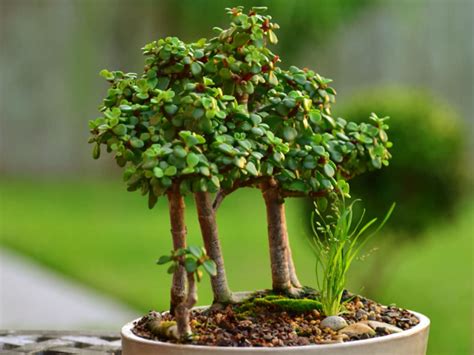
This versatile plant is native to South Africa and even used as livestock feed there—hence the name.
Lighting needs
Prefers bright, indirect light but can adapt to a bit of direct sun.
If grown in too much shade, it may stretch and become leggy.
Place it near a sunny window or in a room that gets lots of natural light.
Soil and watering
Use a cactus or succulent mix with fast drainage.
Water only when the soil is dry to the touch, and make sure the pot drains well.
Cut back watering in winter when the plant naturally slows down.
Why it’s great for beginners
Elephant Bush is incredibly easy to grow and tolerates occasional neglect.
It’s also easy to propagate, making it a great plant to experiment with and share.
Echeveria
Echeveria is the poster child of succulents, known for its tight rosette form and wide variety of colors, shapes, and textures.
Whether pale green, lavender, pink, or even black, these compact plants add a geometric beauty to any arrangement.

They stay small and tidy, making them ideal for tabletop displays.
Lighting needs
Needs bright, direct light to keep its compact rosette form and vibrant color.
Without enough light, the leaves will stretch and lose their symmetry.
South-facing windows are best, or supplement with a grow light.
Soil and watering
Use a sandy, gritty succulent mix.
Let the soil dry out completely before watering, and avoid getting water in the center of the rosette—it can lead to rot.
Water less frequently in cooler months.
Why it’s great for beginners
Echeveria is a low-maintenance plant that looks high-end.
As long as it gets enough sun and isn’t overwatered, it will thrive for years and stay looking like a perfect little sculpture.
Flapjack Plant (Kalanchoe luciae)
Flapjack Plant is a bold succulent with thick, paddle-shaped leaves stacked like pancakes—often edged with a dramatic red blush.
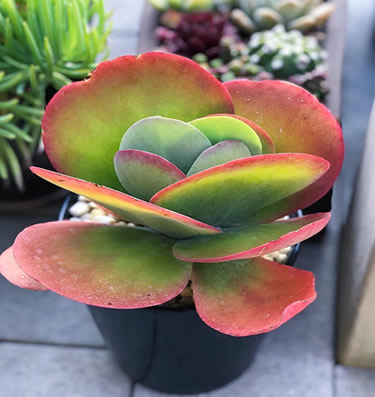
Its architectural shape and eye-catching color make it a standout in any sunny spot, and it stays compact and low-maintenance indoors.
In strong light, the red margins become even more intense.
Lighting needs
Needs plenty of bright, direct sunlight to keep its color and shape.
A south-facing window is ideal, and it can even tolerate a few hours of full sun each day.
Without enough light, the plant may lose its red edges and become leggy.
Soil and watering
Use a fast-draining cactus mix or succulent blend.
Let the soil dry out completely before watering, and avoid splashing water on the leaves to prevent rot spots.
Cut back on watering in winter.
Why it’s great for beginners
Flapjack Plant is striking, slow-growing, and nearly unkillable when given the right light.
Its bold look and forgiving nature make it a top pick for beginners who want something dramatic.
Ghost Plant (Graptopetalum paraguayense)
Ghost Plant has elegant, pastel-toned rosettes that range from pale blue-gray to soft pink—depending on the light it receives.
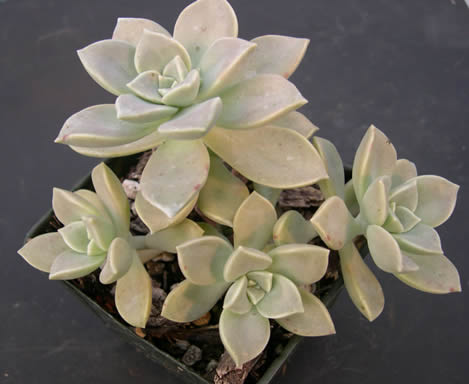
The leaves have a powdery, almost translucent look and can form dense mats or trail over the edge of containers.
It’s a quick grower and looks gorgeous in mixed arrangements.
Lighting needs
Needs bright light to maintain its unique coloration and compact rosettes.
It can handle full sun but may need some afternoon shade in very hot climates.
Rotate regularly for even growth.
Soil and watering
Plant in a gritty succulent mix with good drainage.
Allow the soil to dry out thoroughly between waterings, and reduce frequency in winter.
Avoid overhead watering, which can leave marks on the delicate, powdery leaves.
Why it’s great for beginners
Ghost Plant is low-maintenance, fast-growing, and forgiving.
It’s also easy to propagate from fallen leaves or cuttings, which makes it great for experimenting and expanding your collection.
Hens and Chicks (Sempervivum spp.)
Hens and Chicks form adorable clusters of small rosettes (the “chicks”) around a larger parent plant (the “hen”).
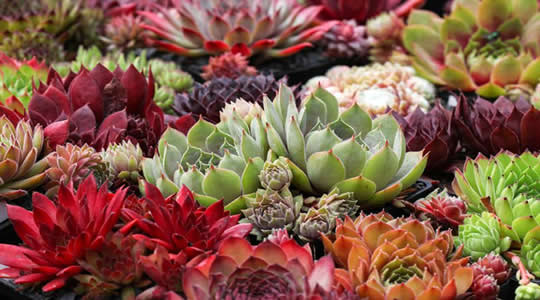
These cold-hardy succulents are often grown outdoors but also make excellent indoor plants in containers and shallow trays.
Their tight, geometric form and ability to multiply make them fascinating to watch over time.
Lighting needs
Full sun to bright, direct light indoors is best.
Place them in a sunny windowsill or under a grow light to keep them compact and vibrant.
Too little light will cause stretching and reduced offsets.
Soil and watering
Use a well-draining cactus mix or sandy blend.
Water deeply only when the soil is completely dry, and reduce watering in winter.
They’re highly drought-tolerant and don’t like wet feet.
Why it’s great for beginners
Hens and Chicks are tough, cute, and multiply on their own.
They require very little care, making them perfect for new plant parents who want a plant that grows with them.
Hoya (Hoya carnosa)
Though often mistaken for a tropical plant, Hoya is actually a semi-succulent with thick, waxy leaves that store water beautifully.
Also called “Wax Plant,” it produces sweetly scented star-shaped flowers when mature, and it’s one of the best trailing succulents for shelves or hanging baskets.
Its vines can grow long and lush, adding a soft, elegant vibe to your space.
Lighting needs
Hoya prefers bright, indirect light and can tolerate a little early morning sun.
Too much direct sun can scorch the leaves, while too little light may delay flowering.
An east- or filtered south-facing window is ideal.
Soil and watering
Use a loose, well-draining mix—cactus soil blended with orchid bark or perlite works well.
Let the top half of the soil dry out before watering again.
It prefers slightly dry conditions over too much moisture.
Why it’s great for beginners
Hoya is low-maintenance, resilient, and can live for years with basic care.
It’s a great pick for anyone who wants a low-fuss trailing plant with a little flowering bonus down the road.
You can read al about the care needs of this beautiful succulent, and see its gorgeous flowers, by visiting Hoya Carnosa Compacta, Hindu Rope Curly Wax Plant Care.
Jade Plant (Crassula ovata)
Jade Plant is a succulent classic—thick, shiny green leaves grow on woody stems, giving it the look of a miniature tree.
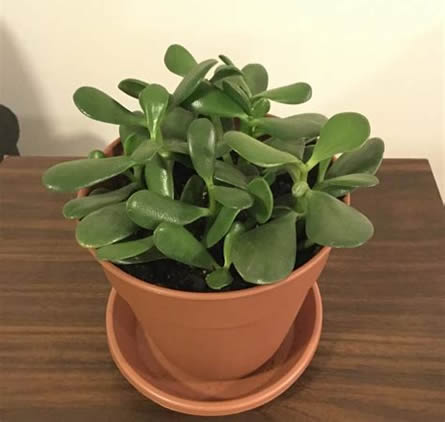
With proper care, it can grow for decades and become quite large, even taking on a bonsai-like shape over time.
It’s considered a symbol of luck and prosperity in many cultures.
Lighting needs
Needs bright, indirect light, though it can handle some direct sun.
South- or west-facing windows are ideal, but protect it from harsh midday rays when young.
If it starts to stretch, it likely needs more light.
Soil and watering
Plant it in a fast-draining succulent mix and let the soil dry out completely before watering.
Overwatering is the most common issue, so err on the side of underwatering.
Reduce watering in winter.
You can read more about teh eay care routine of this succulent in our article How to Care for a Jade Plant (Crassula ovata): A Classic Succulent That Brings Good Vibes and Easy Growth.
Why it’s great for beginners
Jade Plant is tough, forgiving, and incredibly easy to shape and maintain.
Its long lifespan and clean, upright growth habit make it a staple for new plant owners.
Kalanchoe (Kalanchoe blossfeldiana)
Kalanchoe is a flowering succulent that brings a splash of color with its long-lasting blooms in red, pink, yellow, orange, or white.
Its thick, dark green leaves store moisture well, and it stays compact, making it a great addition to small spaces.
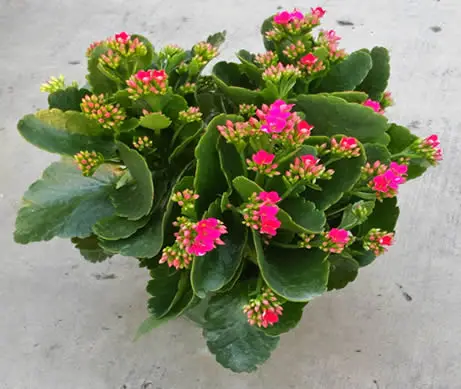
This plant blooms best in bright light and brings a cheerful vibe to any room.
Lighting needs
Needs plenty of bright, indirect light to encourage blooming.
It can handle some direct sun, especially in the morning or late afternoon.
Keep it in a spot with at least 6 hours of light daily for best results.
Soil and watering
Use a cactus mix or fast-draining potting blend.
Let the soil dry out between waterings, and don’t let water collect in the crown.
Water less frequently in winter and after blooms fade.
Why it’s great for beginners
Kalanchoe is colorful, compact, and thrives on neglect.
It’s one of the easiest flowering succulents to grow indoors and adds a pop of brightness with almost no effort.
Lace Aloe (Aloe aristata)
Lace Aloe is a compact succulent with thick, dark green leaves that are speckled with white spots and edged in soft, hair-like spines.
Despite its delicate name, this plant is hardy and easygoing—offering the best of Aloe and Haworthia in one tidy little package.
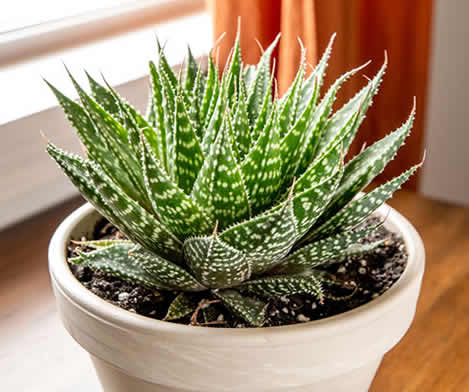
It stays small, making it perfect for desks, windowsills, and succulent groupings.
Lighting needs
Prefers bright, indirect light but can tolerate some direct morning sun.
Too much strong sun may cause leaf tips to brown.
East- or filtered south-facing windows are ideal.
Soil and watering
Plant in a gritty, fast-draining mix—cactus soil works perfectly.
Let the soil dry out completely between waterings, and cut back even more in cooler months.
Avoid watering into the center rosette.
Why it’s great for beginners
Lace Aloe is tough, compact, and incredibly low-maintenance.
Its attractive patterning and easy care make it a go-to for anyone short on space or time.
Lithops (Living Stones)
Lithops are one of the most unusual houseplants you’ll find—tiny, stone-like succulents that blend right into the soil.
Each one is made of two fused leaves that split open as new growth emerges, often followed by a daisy-like flower.
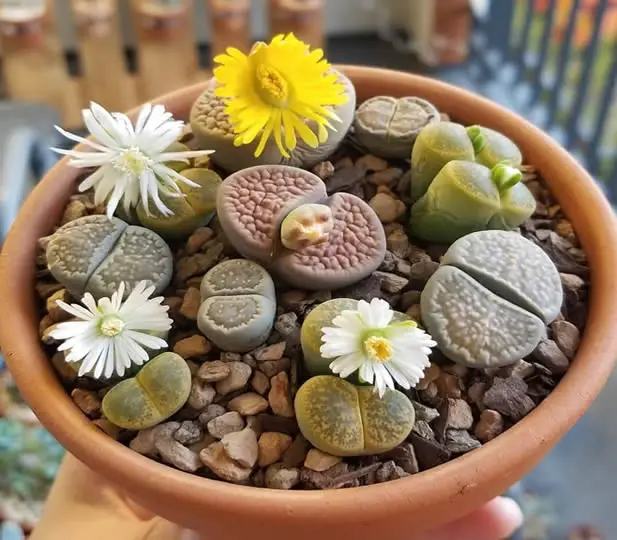
They’re slow-growing but endlessly fascinating.
Lighting needs
Needs bright, direct light for several hours a day.
Place in a south- or west-facing window where they can soak up sun without being scorched.
Rotate occasionally for even growth.
Soil and watering
Use a coarse, sandy mix designed for cacti or succulents.
These plants are incredibly drought-tolerant—water only when the soil is bone dry, and very sparingly in winter.
Overwatering is the most common cause of death.
Why it’s great for beginners
Lithops are low-fuss and require minimal watering.
They’re perfect for curious plant lovers who want something totally different—and surprisingly easy to care for.
Moonstones (Pachyphytum oviferum)
Moonstones look like little clusters of pastel jellybeans, with plump, round leaves that come in silvery blue, pink, or lavender.
Their thick, powdery coating gives them a soft, dreamy appearance, and they stay compact with very slow growth.
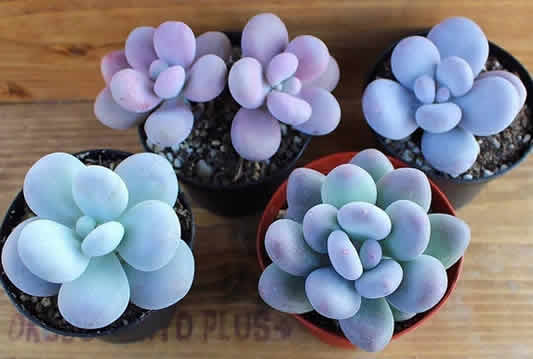
They’re great for small planters or mixed succulent pots.
Lighting needs
Needs bright, indirect light or a few hours of gentle direct sun.
Without enough light, the plant will stretch and lose its rosette form.
Keep it in a spot with filtered sunlight or near a grow light if needed.
Soil and watering
Use a fast-draining succulent mix.
Let the soil dry out completely between waterings, and avoid touching the leaves—their powdery coating can rub off easily.
Water less in winter and during periods of slow growth.
Why it’s great for beginners
Moonstones are adorable, compact, and surprisingly hardy.
With the right light and a gentle hand, they’ll thrive with very little effort.
Panda Plant (Kalanchoe tomentosa)
Panda Plant is a fuzzy-leaved succulent with silvery green foliage and chocolate-brown tips.
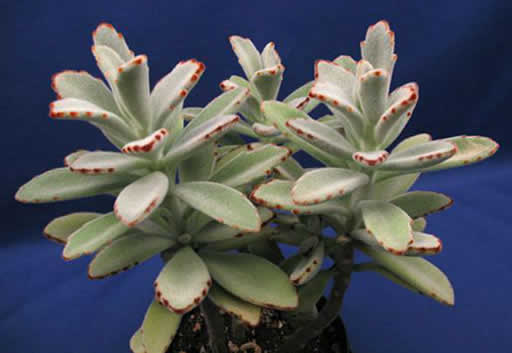
Its soft texture and upright, compact growth make it a standout in small containers—and it’s just as fun to touch as it is to look at.
It’s slow-growing and very forgiving of neglect.
Lighting needs
Prefers bright, indirect light but can tolerate a bit of direct morning sun.
Avoid strong afternoon rays, which can scorch the fuzzy leaves.
Rotate occasionally for even growth.
Soil and watering
Use a well-draining succulent mix, and let the soil dry out fully before watering.
Water at the base to avoid wetting the leaves, which can lead to rot or mold.
Water less often in winter.
Why it’s great for beginners
Panda Plant is soft, quirky, and nearly impossible to kill.
It thrives in bright rooms and forgives occasional forgetfulness, making it perfect for new plant parents.
Peanut Cactus (Echinopsis chamaecereus)
Peanut Cactus is a low-growing, clumping cactus with finger-like stems that spread out like little green noodles.
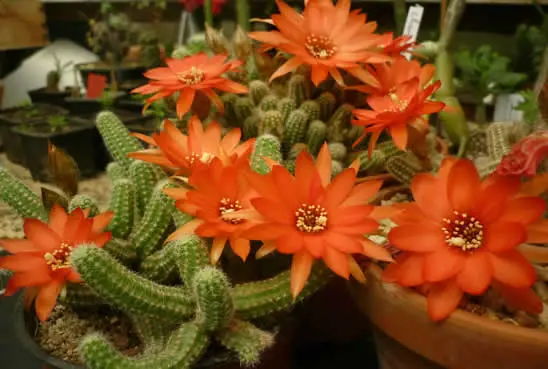
In spring or summer, it often bursts into bloom with bright orange or red flowers that are almost bigger than the plant itself.
Its small size and fast growth make it a favorite for dish gardens.
Lighting needs
Loves bright light and full sun.
Place it near a south-facing window or somewhere it gets at least 4–6 hours of direct sunlight each day.
Soil and watering
Use a fast-draining cactus mix.
Allow the soil to dry out completely between waterings and avoid splashing water on the stems.
Cut back watering in winter when growth slows.
Why it’s great for beginners
Peanut Cactus is compact, colorful, and thrives on minimal care.
It’s one of the few cacti that reliably blooms indoors, making it an extra-rewarding choice.
Pencil Cactus (Euphorbia tirucalli)
Pencil Cactus is a sculptural succulent with thin, upright stems that resemble green twigs.
In bright light, its tips can turn pink or coral, giving it the nickname “Sticks on Fire.”
It grows tall and narrow, making it great for corners or modern plant displays.
Lighting needs
Needs very bright, direct light to grow well.
Place it near a sunny window or even outdoors in summer for maximum color and growth.
It’s not suited for low-light spaces.
Soil and watering
Use a fast-draining cactus or succulent mix.
Water sparingly—let the soil dry out completely, and water deeply when you do.
It stores plenty of water in its stems.
Why it’s great for beginners
Pencil Cactus is bold, architectural, and drought-tolerant.
Once you find it a sunny spot, it practically takes care of itself.
Pleiospilos nelii (Split Rock)
Split Rock is a small, dome-shaped succulent that looks just like a cracked stone sitting in the soil.
Split Rock
Split Rock
Its thick leaves grow in pairs and split open to allow new growth or even flowers to emerge.
This slow-growing plant is easy to care for and adds a fun, sculptural element to any succulent display.
Lighting needs
Needs bright, direct light to maintain its compact, round shape.
South-facing windows are ideal, but filtered light will work too as long as it’s bright enough.
Turn the pot occasionally for even growth.
Soil and watering
Use a gritty, well-draining cactus mix with added sand or pumice.
Allow the soil to dry out completely before watering again, and reduce watering significantly during winter dormancy.
Too much water will cause the plant to split or rot.
Why it’s great for beginners
Split Rock is small, tidy, and thrives on neglect.
It’s perfect for minimalists or anyone who wants a plant that doesn’t demand much but still looks unique.
Ponytail Palm (Beaucarnea recurvata)
Ponytail Palm isn’t a true palm—it’s a succulent with a thick, bulbous base that stores water and long, ribbon-like leaves that cascade like a ponytail.
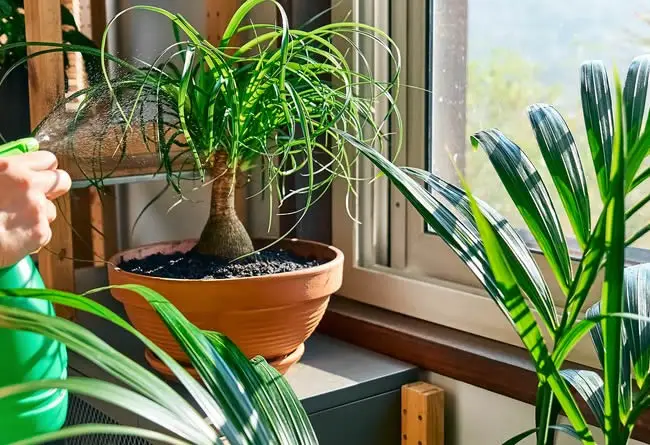
It has a clean, modern look and grows slowly, so it’s perfect for small spaces or tabletop displays.
Despite its tropical appearance, it’s incredibly drought-tolerant.
Lighting needs
Prefers bright, indirect light but can handle some direct sun.
East- or south-facing windows work well, and it can even adapt to lower light conditions if necessary.
Soil and watering
Use a well-draining cactus mix and allow the soil to dry out fully between waterings.
Water deeply and infrequently, and never let it sit in soggy soil.
In winter, cut back watering even further.
Why it’s great for beginners
Ponytail Palm is visually striking, low-maintenance, and thrives on a set-it-and-forget-it routine.
It’s perfect for anyone who wants a sculptural statement plant with almost zero upkeep.
You can read more about this succulents care needs in the article Ponytail Palm Care: How to Grow This Playful, Drought-Loving Houseplant.
Purslane (Portulaca oleracea)
Purslane is a spreading succulent with small, rounded leaves and colorful flowers that open in bright light.
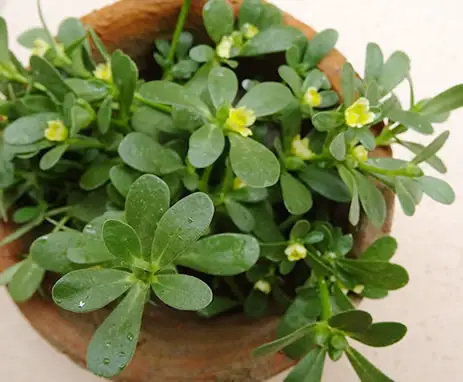
Often grown outdoors in warm climates, it also does well indoors in sunny spots where it can trail or spread as a cheerful groundcover-like plant.
Some varieties are even edible.
Lighting needs
Loves full sun—at least 6 hours of direct sunlight daily is ideal.
It will bloom more often and grow more compactly with strong light.
A bright windowsill or sunroom is perfect.
Soil and watering
Plant it in well-draining soil and let the mix dry out between waterings.
Water deeply but infrequently, and cut back when temperatures cool.
It’s very tolerant of drought once established.
Why it’s great for beginners
Purslane is colorful, fast-growing, and super easy to care for.
If you’ve got a bright window and a sunny vibe, this plant will fit right in.
Ruby Necklace (Othonna capensis)
Ruby Necklace is a trailing succulent with small, bean-shaped leaves on stems that turn bright red or purple when exposed to sunlight.

It produces tiny yellow daisy-like flowers and grows quickly, making it ideal for hanging baskets or shelf edges where it can spill over stylishly.
Lighting needs
Needs bright, indirect light to maintain its vibrant color.
Some morning or late afternoon sun will deepen the ruby tones in the stems.
It also does well under grow lights.
Soil and watering
Use a fast-draining succulent or cactus mix.
Water when the soil is completely dry, and cut back watering in the cooler months.
It stores plenty of moisture in its leaves and stems.
Why it’s great for beginners
Ruby Necklace grows quickly, trails beautifully, and adds a pop of color to your plant collection—all with very little effort.
It’s a great introduction to fast-growing, low-fuss trailing succulents.
Snake Plant (Dracaena trifasciata)
Snake Plant, also known as Mother-in-Law’s Tongue, has upright, sword-like leaves that are often striped in green, silver, or gold.
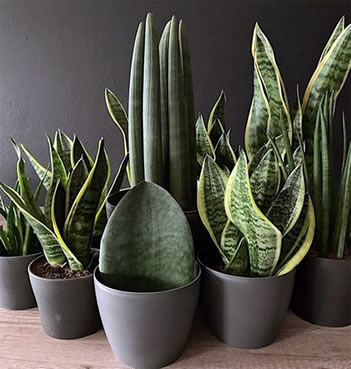
This architectural succulent is one of the toughest houseplants around and even purifies the air as it grows.
Its rigid, vertical form works well in corners, entryways, and modern decor.
Lighting needs
Thrives in bright, indirect light but also tolerates low-light conditions.
It’s one of the few succulents that can handle a dim room without much complaint.
South, east, or even north windows are all acceptable.
Soil and watering
Use a well-draining mix and let the soil dry out completely between waterings.
Water sparingly—once every 2–3 weeks is usually enough, and even less in winter.
Avoid watering directly into the center of the rosette.
Why it’s great for beginners
Snake Plant is practically indestructible.
It can handle low light, long dry spells, and general neglect—making it one of the absolute best starter succulents out there.
For a more in-depth look at the care needs of this succulent review our article Snake Plant Care Made Easy.
String of Bananas (Senecio radicans)
String of Bananas is a fast-growing trailing succulent with curved, banana-shaped leaves that grow along cascading vines.
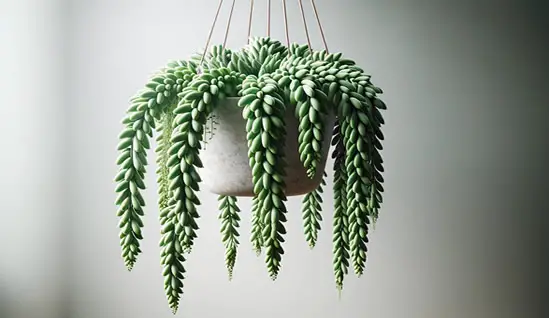
It adds texture and movement to hanging planters, and its quirky shape makes it a conversation piece.
It’s also easier to grow than many other trailing succulents.
Lighting needs
Prefers bright, indirect light and will grow quickly with at least a few hours of sun daily.
East- or west-facing windows are ideal.
Rotate regularly for even trailing.
Soil and watering
Use a gritty, fast-draining succulent mix and allow the soil to dry completely before watering.
Overwatering can cause root rot, so err on the dry side.
Reduce watering in cooler months.
Why it’s great for beginners
String of Bananas grows faster and is more forgiving than String of Pearls, making it a great entry-level trailing succulent.
It brings personality and flow to any plant setup.
String of Pearls (Senecio rowleyanus)
String of Pearls is a striking trailing succulent made up of tiny, round “pearl” leaves that drape beautifully from hanging pots.
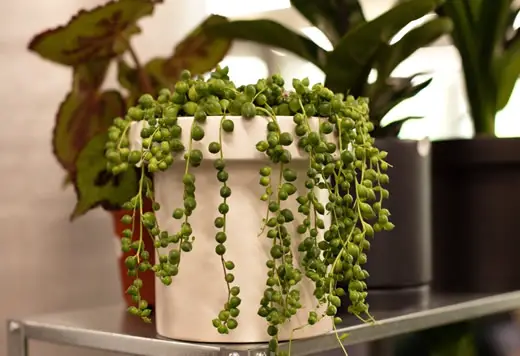
Its unique shape and cascading growth give it an elegant, whimsical feel—and when it flowers, it produces small, cinnamon-scented white blooms.
Lighting needs
Needs bright, indirect light with a few hours of direct sun to grow well and keep its shape.
East- or south-facing windows are perfect.
Too little light causes the strands to thin and stretch.
Soil and watering
Use a very fast-draining succulent mix.
Let the soil dry out completely between waterings, and water deeply but infrequently.
Avoid getting water on the leaves to prevent rot.
Why it’s great for beginners
While slightly more delicate than some succulents, String of Pearls is easy to manage once you get the watering right.
Its unusual look and fast trailing habit make it a fun, stylish plant to grow.
Zebra Haworthia (Haworthiopsis attenuata)
Zebra Haworthia is a small but bold succulent with dark green leaves lined with white, bumpy stripes.
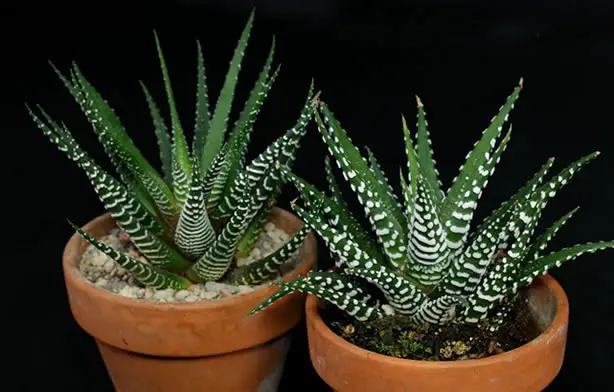
Its upright, compact form and slow growth make it a fantastic choice for desks, bookshelves, and windowsills.
It looks like a tiny aloe but is even easier to care for.
Lighting needs
Bright, indirect light is ideal, though it can handle low light better than many other succulents.
Avoid prolonged direct sun, which can cause discoloration.
Rotate occasionally for balanced shape.
Soil and watering
Use a cactus or succulent mix with great drainage.
Water when the soil is fully dry, and keep it even drier in winter.
It thrives with minimal attention.
Why it’s great for beginners
Zebra Haworthia is practically made for beginners—low water needs, small footprint, and very little fuss.
It’s the perfect desk plant for anyone just starting their plant journey.
ZZ Plant (Zamioculcas zamiifolia)
ZZ Plant is a bold, glossy succulent with upright stems and dark green, waxy leaves that shine like polished jade.
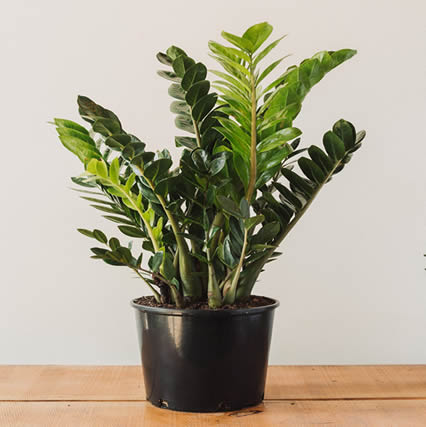
It stores water in its rhizomes beneath the soil, so it can survive long dry spells with ease.
It’s nearly indestructible and looks fantastic in modern interiors.
Lighting needs
Tolerates everything from bright, indirect light to low light.
It won’t grow quickly in low light, but it will survive—making it ideal for offices or north-facing rooms.
Avoid direct sunlight, which can scorch its leaves.
Soil and watering
Use a well-draining potting mix and let the soil dry out fully before watering.
Watering too frequently is the easiest way to harm this plant.
It’s extremely drought-tolerant thanks to its underground storage system.
Why it’s great for beginners
ZZ Plant is one of the hardest plants to kill.
It handles low light, irregular watering, and neglect like a champ—and still looks amazing.
Final Thoughts
Succulents are some of the easiest and most rewarding houseplants for beginners.
They’re sculptural, low-maintenance, and come in an incredible variety of forms—from elegant trailing vines to bold, geometric rosettes.
Whether you have a sunny windowsill, a small apartment, or a full plant shelf waiting to be filled, there’s a succulent on this list that will thrive with minimal effort.
Choose one or two to start with, get to know their simple needs, and let your confidence grow from there.
With the right light, the right soil, and a light hand on the watering can, you’ll have a thriving succulent collection in no time.

